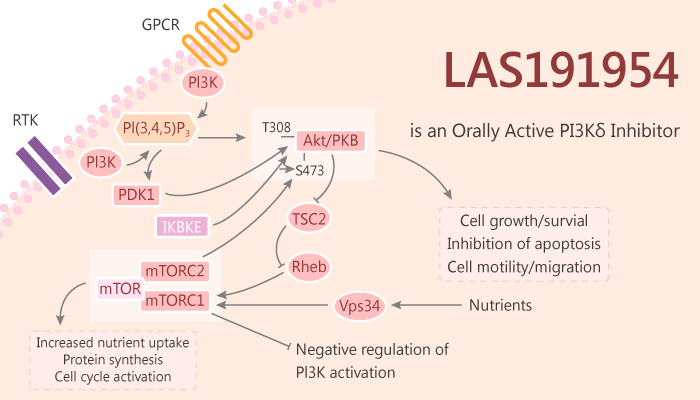The phosphatidylinositol-3-kinase (PI3K) signal transduction pathway plays an indispensable role in different cellular processes involving metabolism, proliferation, differentiation or activation. Therefore, targeting PI3K pathway represents an interesting approach in diseases therapy, including cancer, and varies inhibitors of PI3K with different isoform selectivity have already been established.
In the immune system, the PI3K delta isoform plays a central role in both innate and adaptive immune cell functions. Specially, Idelalisib, an orally active PI3Kδ inhibitor, has been widely applied to treat different types of B cell malignancies. In addition, PI3Kδ inhibitors act as novel broad-acting anti-inflammatory agents for autoimmune diseases and pathologies with an allergic or inflammatory disease, such as asthma and COPD. Apart from inhibiting B cell activation, PI3K delta also attenuated T cell receptor induced cytokine production. In addition, PI3Kδ seems to be involved in corticosteroid resistance induced by oxidative stress in macrophages.
A study from Montse Erra discovered and identified LAS191954 as an orally active and selective PI3Kδ inhibitor.

In vitro, LAS191954 showed an IC50 of 2.6 nM for PI3Kδ and 7.8 nM for M-CSF p-AKTb. Additionally, on isolated PBMC, LAS191954 showed an IC50 of 4.6 nM.
In vivo, LAS191954 exhibited excellent pharmacological profile. LAS191954 (compound 26) showed excellent oral bioavailability and low clearance in rat and dog.
Moreover, to identify the effect of LAS191954 on T cell cytokine production in vivo, the authors used a rat model of con A induced IL2 production. LAS191954 was administered orally hour prior to an intravenous con A challenge (10 mg/kg) and IL2 levels were measured 90 minutes later. As a result, LAS191954 inhibited IL2 production with an ID50 of 0.13 mg/kg as compared to an ID50 of 1.6 mg/kg of Idelalisib.